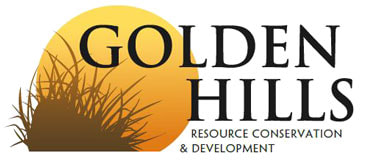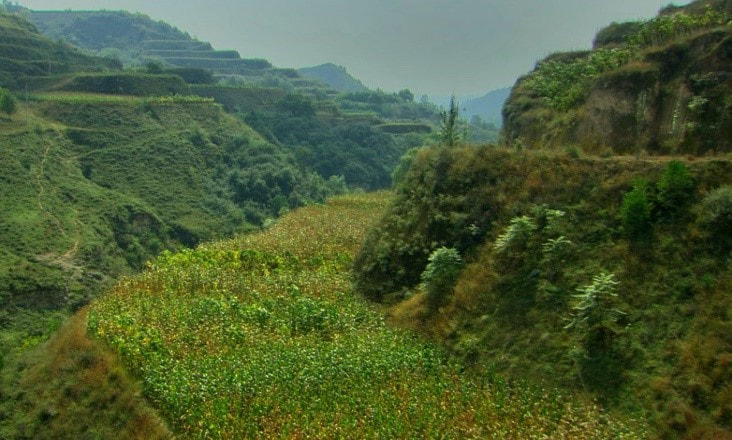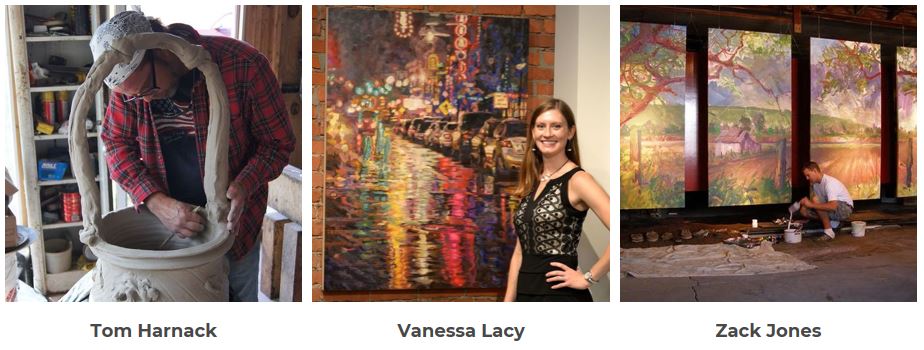|
By Bill Blackburn
(first in a series of Loess Hills articles. Stay tuned for future posts!) Take a drive along I-29 any fine day and you will see an extremely rare site—the Loess Hills. “Loess,’ which according to Webster can be pronounced as “luss,” “Lois,“ or “less,” is a German term meaning loose or crumbly. It refers to a yellowish deposit of wind-blown rock dust found in Germany, Argentina, New Zealand, U.S., China, and many other parts of the world. However, it forms hills of significant height (60-350 feet) only in two places: in the Yellow River region in and around Shaanxi province, China, and in the mini-mountains (bluffs) in the Midwest U.S. running parallel to the Missouri River 220 miles from Mound City, MO to Westfield, IA. In Iowa, the beautiful sharp-cliffed hills pass through the western sides of Fremont, Mills, Pottawattamie, Harrison, Monroe, Woodbury, and Plymouth Counties. Our 640,000-acre bluffs are geologically speaking relatively new, having been formed only 12,000 t0 115,000 years ago when glaciers were grinding rock into powder in the north, which was carried down the Missouri River, deposited on the bottom ground and eventually blown westerly into dunes. But the granddaddy of loess hills is the Chinese “Loess Plateau,” which covers an area only slightly less than the entire state of Texas located several hundred miles southwest of Beijing. In China, the loess eroded from various mountain areas over millions of years, was collected in the Gobi and other deserts and from there was blown into the plateau. But the wind is still at work there, causing the plateau to gradually move to the southeast over time. As in the U.S., the Chinese loess is highly erodible, so much so that the Yellow River which passes through the plateau was named because of the vast amounts of yellow-brown loess it carries downstream. The Loess Hills are rich aesthetically, ecologically, and historically. The U.S. Loess Hills Byway, which threads through the hills, was named one of the 10 most scenic roads in the country by nonprofit Scenic America. The state of Iowa has cited 39 rare animal and plant species in the hills. Hills animals such as the plains pocket mouse, ornate box turtle, Great Plains skink (lizard), and spadefoot toad are becoming rare and even endangered. Bald eagles and a wide range of other birds reside there or pass through annually. The bluffs contain three-fourths of Iowa’s remaining natural prairies. The Bluffs region is one of the country’s prehistoric gems, having been traversed by humans for over 12,000 years. It is home to more than 800 archeological sites, including late settlements of Mill Creek (900 AD), where predecessors of the Mandan tribe resided, and the Glenwood site (1000 AD or so), where 80 lodge sites of Pawnee and Arikaras ancestors were discovered. The region opened the gates for pioneers moving westward from there through the Mormon, California and Oregon Trails, and later, from the eastern terminus of the transcontinental railroad. The history of China’s Loess Plateau is even more impressive. It is the location of the 1.3 million-year-old site displaying the oldest use of fire by Homo erectus, the predecessor to modern humans. The fertility of the region around the Yellow River valley enabled it to become the cradle of Chinese civilization. It was an important trading center on the famous Silk Road. Its military importance was reflected by the famous terra cotta army of the Qin Dynasty Emperor that was buried there. The region served as the home to subsequent Chinese dynasties up to the 900s AD, when the capital was moved, eventually to Beijing. By the time the center of Chinese culture had move out of the Loess Plateau, the area had become massively eroded from overgrazing and deforestation, with the resulting erosion filling the Yellow River with deposits of so much loess that devastating flooding of croplands became common. A huge restoration project funded largely by the World Bank set out to partially restore the plateau over an area roughly the size of New Jersey. Whether in China or Western Iowa, the loess hills are a rare gem of past, present and future importance—aesthetically, ecologically, historically and economically. They deserve our appreciation.
0 Comments
The Iowa Department of Natural Resources, Golden Hills RC&D and the Loess Hills National Scenic Byway are excited to announce the Waubonsie State Park Artist in Residence awards for the Spring of 2019! Many quality applications were received from a variety of disciplines and artists in six different states. Three artists were selected to fill residencies from January through April of next year. Artists receiving the residency awards for 2019 include Thomas Harnack, Vanessa Lacy and Zack Jones. The goal of the residency program is to reach a broader audience of park-goers, thus increasing the number of visitors and ultimately educating more people about the Loess Hills ecosystem. The artists and visitors will engage with the natural resources of the park through a visual arts lens. This year’s residency program’s three artists will use their time at Waubonsie to immerse themselves in the landscape as a source of inspiration and opportunity to intensely focus on their work.
Tom Harnack was born and raised in Carroll, Iowa area and has been a dedicated artist for the past 37 years. While at Waubonsie he plans to focus his work on ceramics. Excited about the opportunity for a residency program at Waubsonsie State Park, Tom reflects on the Loess Hills, “I feel as an artist, nature is my main inspiration. When I fire my wood kiln, it takes 7 days outdoors. Whether it be the owls in the grove, or the stars before sunrise, it’s being in the natural environment that inspires my creativity.” Vanessa Lacy grew up in rural Adrian, Missouri. She currently owns a gallery in Kansas City, Missouri, although she often escapes the city to paint in rural areas to seek nature as a source of inspiration and tranquility. Vanessa’s vision for her residency fits well with that of the program as a whole. “I believe art and the parks have always gone hand in hand. The park inspires the artist and the artist’s work inspires more visitors to visit.” Vanessa’s work will be primarily oil paint on panel, and her outreach will feature painting workshops. Zack Jones was raised in Malvern, Iowa but began his self-taught art career while living in Tempe, Arizona. While there, he was mentored by lifetime artist Sergio Ladron De Guevara, who taught Zack traditional art and to paint with love. Since returning to his hometown in 2006, he has done just that –connecting his art to historical preservation, recreation and rural Southwest Iowa. Zack is currently doing a residency program at Whiterock Conservancy, which ties into his goal of connecting traditional landscape paintings to conservation programs. “I would like to use my paintings to highlight the unique geography while highlighting Waubonsie State Park. My artwork is at its best when there is a personal connection and common interest with others.” Artist Sarah Berkeley is currently piloting the residency program at Waubonsie and helping to finalize program details. Sarah was born on the North Shore of Massachusetts and subsequently spent her childhood in Michigan and Colorado. She works across media questioning cultural norms such as the 9:00 to 5:00 work day, the office environment, indoor living, gender stereotypes and the voluntary sharing of personal data. She creates public interventions and durational performances which she documents using photography, video and GPS. This first-in-the-state Artist in Residency program at one of Iowa’s State Parks is held at one of the region’s ecological and recreational treasures. Located in the Loess Hills of Southwest Iowa, the park’s 2,000 acres feature prairies, savannas, and woodlands which are home to diverse flora and fauna, not to mention breathtaking vistas. Waubonsie State Park Manager Matt Moles has been working with artist Sarah Berkeley, Golden Hills RC&D Project Coordinator Lance Brisbois and Loess Hills National Scenic Byway Coordinator Rebecca Castle to develop and launch the project. While there have been other artist residency programs offered through the National Parks System and select parks in other states, this will be the first such program in one of Iowa’s State Parks. The program is loosely modeled after similar regional programs such as the Residency Program at Kimmel Harding Nelson Center for the Arts. The artists will receive lodging in a studio cabin and a primitive studio space in the park at no cost for the duration of the residency. In return, artists will deliver at least one public program per month of their residency and donate one piece of art to the park at the conclusion of their stay. Waubonsie State Park is only about an hour’s drive from Omaha or Lincoln, NE; two hours from Kansas City; and 2.5 hours from Des Moines. It is located near the southern end of the Loess Hills National Scenic Byway. To learn more about the Artist in Residence program and the artists, visit www.goldenhillsrcd.org/artist-in-residence. |
Archives
April 2024
Categories
All
|
Address712 South Highway Street
P.O. Box 189 Oakland, IA 51560 |
ContactPhone: 712-482-3029
General inquiries: info@goldenhillsrcd.org Visit our Staff Page for email addresses and office hours. |



 RSS Feed
RSS Feed